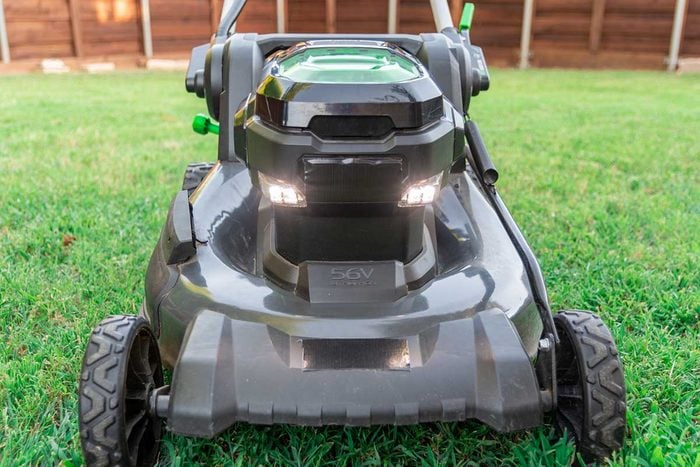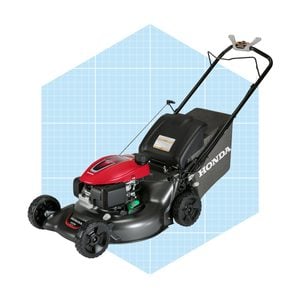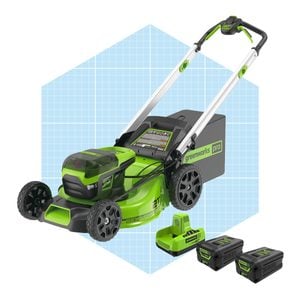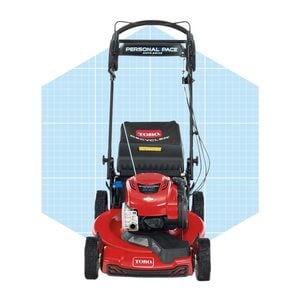What to Consider When Buying a Self-Propelled Lawn Mower
Updated: Jan. 04, 2024

What are the key features to look for in a self-propelled mower, and how do you know if these mowers are the best choice for you? Read on to find out.
Our editors and experts handpick every product we feature. We may earn a commission from your purchases.
Lawn mowers have come a long way since the first model was invented in the 1830s. They’ve transformed from heavy and clunky into easy-to-use machines. By the 1990s, self-propelled mowers were widely available, allowing users to simply walk behind and guide the mower.
Self-propelled mowers are a perfect choice for yards that are too large or uneven to be easily covered by a push mower, but not quite big enough for a riding mower. For most homeowners, that usually means a lot size of about one-third to one-half acre.
There are a wide variety of self-propelled mowers on the market these days, from gas-powered to electric models, along with tons of features that can really help with yard work. Costs for self-propelled mowers can range from several hundred dollars to thousands. Before you make the commitment, it’s important to decide whether or not a self-propelled mower is right for you, as well as what kind of features you actually need and what’s just an extra cost.
On This Page
What Is a Self-Propelled Lawn Mower?
In a self-propelled mower, the engine powers some or all of its wheels, providing forward momentum along with spinning the blades. This functions a little like putting a car with an automatic transmission into drive. It will slowly pull itself forward until you apply the brakes or, in the case of the lawnmower, pull backward.
What’s the Difference Between Manual, Push and Self-Propelled Mowers?
This is a common question, because the terminology can be confusing.
Manual mowers do not have a motor. You provide the power by pushing forward.
A push mower has a gas or electric motor that powers the blades. The mower has four wheels, and only moves when the user pushes or pulls it.
Self-propelled mowers are a variation of a push mower. As mentioned above, the motor spins the blades and moves the wheels forward without physical pressure from the user.
Self-Propelled Lawn Mower Features and Benefits
- The drive train. Front wheel drive mowers are often the most affordable and a great choice if you just need a simple assist for a large yard. But if the mower’s center of balance shifts, the front wheels can lose their traction. This can happen going up a hill, crossing uneven terrain or even because the grass collection bag is full. If you have a sloped yard or if you’ll regularly bag your clippings, consider a rear wheel drive mower instead. Extremely uneven yards are a good fit for an all wheel drive mower. (There are ways to improve lawn mower traction yourself.)
- Variable speed control. On these models the speed is controllable, usually relative to how much pressure you apply on a handle or lever. This is a great feature if you want to stick to a comfortable pace but need the occasional boost to get up a hill or over uneven ground.
- A basic kill switch. All modern self-propelled mowers have this feature so the self-propulsion won’t function if you let go of the handle. This is essential to make sure the mower doesn’t run off on its own. Some mowers have additional safety features such as disengage the blades without turning off the motor, or vibration absorbers to limit stress fatigue in the hands.
- Other popular features include a hose attachment to wash off the deck, an electric starter on gas motors and an extra-wide cutting deck. Although none of these are required to mow your lawn, they all make it easier.
Self-Propelled Mower Cost and Brands
The added parts and additional engine power mean self-propelled mowers cost more than a standard push mower, but far less than a riding lawn mower. There are affordable lawn mowers available in this category. Expect to pay $300 or more for a self-propelled mower, and up to $1,200 for brand name models loaded with additional features.
Most homeowners will likely find the right balance of power and price around $350 to $400.
Leading mower brands include names familiar to anyone who works with outdoor power tools. Honda, Toro, Troy-Bilt, Craftsman and more all have self-propelled mowers. Honda has announced that it will no longer manufacture new gas-powered lawn mowers.
Cordless mowers generally cost slightly more than their gas-powered equivalents, although that gap has been shrinking in the past few years. EGO and Greenworks are known for cordless mowers, but other manufacturers are catching up.
Some of Our Favorite Self-Propelled Mowers
How Long Do Self-Propelled Lawn Mowers Last?
A self-propelled mower should last eight years or more, depending on how often it’s used. (Most manufacturers rate their mowers for a set number of service hours.) There’s no significant difference in the service life of a self-propelled mower versus a standard push model.
Naturally, any complex system will require maintenance and repairs. Expect to take a self-propelled mower in for annual tuneups, or plan on doing some DIY maintenance to get your mower ready for spring and to put it away in the fall.
Overall, the benefits of self-propelled mowers certainly justify the added cost. The real question is whether you need those benefits for your yard.
If your budget is tight or you don’t feel you need a power assist mow your lawn, then a self-propelled mower probably isn’t worth the added cost. But if you love the idea of spending less time mowing, or if your yard is in that zone of “big enough to be a hassle but not big enough to justify a riding mower,” then a self-propelled mower is a great solution.


